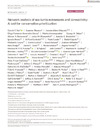Please use this identifier to cite or link to this item:
https://accedacris.ulpgc.es/handle/10553/114072
| Title: | Network analysis of sea turtle movements and connectivity: A tool for conservation prioritization | Authors: | Kot, CY Akesson, S Alfaro-Shigueto, J Llanos, DFA Antonopoulou, M Balazs, GH Baverstock, WR Blumenthal, JM Broderick, AC Bruno, I Canbolat, AF Casale, P Cejudo, Daniel Coyne, MS Curtice, C DeLand, S DiMatteo, A Dodge, K Dunn, DC Esteban, N Formia, A Fuentes, MMPB Fujioka, E Garnier, J Godfrey, MH Godley, BJ Carman, VG Harrison, AL Hart, CE Hawkes, LA Hays, GC Hill, N Hochscheid, S Kaska, Y Levy, Y Ley-Quinonez, CP Lockhart, GG Lopez-Mendilaharsu, M Luschi, P Mangel, JC Margaritoulis, D Maxwell, SM McClellan, CM Metcalfe, K Mingozzi, A Moncada, FG Nichols, WJ Parker, DM Patel, SH Pilcher, NJ Poulin, S Read, AJ Rees, AF Robinson, DP Robinson, NJ Sandoval-Lugo, AG Schofield, G Seminoff, JA Seney, EE Snape, RTE Tomas, J Varo Cruz, Nuria Wallace, BP Wildermann, NE Witt, MJ Zavala-Norzagaray, AA Halpin, PN |
Editors: | Pirotta, Enrico | UNESCO Clasification: | 240119 Zoología marina | Keywords: | Betweenness Centrality Closeness Graph theory Marine turtle, et al |
Issue Date: | 2022 | Journal: | Diversity and Distributions | Abstract: | Aim. Understanding the spatial ecology of animal movements is a critical element in conserving long-lived, highly mobile marine species. Analyzing networks developed from movements of six sea turtle species reveals marine connectivity and can help prioritize conservation efforts. Location: Global. Methods: We collated telemetry data from 1235 individuals and reviewed the literature to determine our dataset's representativeness. We used the telemetry data to develop spatial networks at different scales to examine areas, connections, and their geographic arrangement. We used graph theory metrics to compare networks across regions and species and to identify the role of important areas and connections. Results: Relevant literature and citations for data used in this study had very little overlap. Network analysis showed that sampling effort influenced network structure, and the arrangement of areas and connections for most networks was complex. However, important areas and connections identified by graph theory metrics can be different than areas of high data density. For the global network, marine regions in the Mediterranean had high closeness, while links with high betweenness among marine regions in the South Atlantic were critical for maintaining connectivity. Comparisons among species-specific networks showed that functional connectivity was related to movement ecology, resulting in networks composed of different areas and links. Main conclusions: Network analysis identified the structure and functional connectivity of the sea turtles in our sample at multiple scales. These network characteristics could help guide the coordination of management strategies for wide-ranging animals throughout their geographic extent. Most networks had complex structures that can contribute to greater robustness but may be more difficult to manage changes when compared to simpler forms. Area-based conservation measures would benefit sea turtle populations when directed toward areas with high closeness dominating network function. Promoting seascape connectivity of links with high betweenness would decrease network vulnerability. | URI: | https://accedacris.ulpgc.es/handle/10553/114072 | ISSN: | 1366-9516 | DOI: | 10.1111/ddi.13485 | Source: | Diversity and Distributions [ISSN 1366-9516], v. 28(4), p. 810-829 |
| Appears in Collections: | Artículos |
SCOPUSTM
Citations
25
checked on Jun 8, 2025
WEB OF SCIENCETM
Citations
24
checked on Jun 8, 2025
Page view(s)
102
checked on Feb 22, 2025
Download(s)
116
checked on Feb 22, 2025
Google ScholarTM
Check
Altmetric
Share
Export metadata
Items in accedaCRIS are protected by copyright, with all rights reserved, unless otherwise indicated.
